There are a number of bugs that can infest your plants, either indoors or outdoors. If you notice your plant is not growing the same as it once did, is a different color, or has visible bugs on it, you need to take action in order to save your potted plant.
Plants are known to bring around bugs, after all many bugs sustain life by using plants as their food and home. Carefully inspecting your plants on a regular basis will help prevent an outbreak from getting too bad. Here we detail the most common types of bugs found on plants, as well as ways you can help prevent an infestation from taking your favorite potted plants hostage.
6 Of The Most Common House Plant Bugs:
If you are dealing with a bug infestation on your potted plants, you might be unsure what sort of bug you are dealing with. This list of the most common plant pests will help you determine the type of critter ‘bugging’ your plants.
1. Aphids
Aphids are commonly found on houseplants, and can deter plant growth 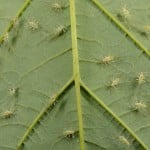 by removing sap from the plant. Eventually, this robs the plant of vital nutrients, while the aphids colony continues to grow. Plants that have a serious aphids infestation become sticky with the honeydew this bug secretes.
by removing sap from the plant. Eventually, this robs the plant of vital nutrients, while the aphids colony continues to grow. Plants that have a serious aphids infestation become sticky with the honeydew this bug secretes.
This bug is usually visible on the underside of leaves huddled together in a cluster, and can be the same green color as your plant. The most natural way to get rid of aphids is to introduce ladybugs into the picture. (Read more about Aphids)
2. Spider Mites
You may need to bust out the magnifying glass in order to spot signs of 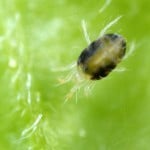 spider mites, as these bugs are incredibly tiny. Plants that have spider mites typically lose their bright green coloring in exchange for a dull brown or washed out appearance.
spider mites, as these bugs are incredibly tiny. Plants that have spider mites typically lose their bright green coloring in exchange for a dull brown or washed out appearance.
Severe infestations will come with webbing all over the undersides of the leaves, and at this point it becomes difficult to eradicate the mites. Insecticides will not work to get rid of spider mites because they are not insects.
Steps to take to solve a spider mite infestation:
- Isolate your plant
- Use soap and water to spray the plant on a regular basis, remember spider mites reproduce at a rapid rate every 3-7 days.
- If possible, relocate the infested plant to a humid space, spider mites like dry air for breeding.
(Learn more about Spider Mites)
3. Mealybugs
We have discussed mealybugs in a previous blog; these very determined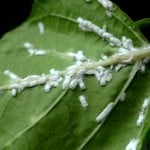 bugs tend to return time and time again. A white cotton-like ‘fluff’ growing over your plant can identify mealybugs. The white is partially the mealy bugs but also it is the waxy substance the bug secretes, which also works to help protect them from being sprayed off.
bugs tend to return time and time again. A white cotton-like ‘fluff’ growing over your plant can identify mealybugs. The white is partially the mealy bugs but also it is the waxy substance the bug secretes, which also works to help protect them from being sprayed off.
A Q-Tip with alcohol on it can be spread over the plant to kill off the mealybugs. You want to continually dose the plant with a stream of water to loosen all of the mealybugs. Next, apply a generous coat of neem oil over the plant so that the bugs are unable to return. (Read more about Mealy Bugs)
4. Whitefly
The whitefly is able to leave the plant the moment you start spraying it, 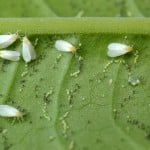 but as soon as you stop spraying the whitefly will return, this is why attacking mature whiteflies is useless. Instead it’s the baby whiteflies you want to go after because they do not move. Dipping leaves in insecticidal soap or spraying the plant regularly can help get rid of the larva so that you don’t continue to have an issue with whiteflies. (More on Whiteflies)
but as soon as you stop spraying the whitefly will return, this is why attacking mature whiteflies is useless. Instead it’s the baby whiteflies you want to go after because they do not move. Dipping leaves in insecticidal soap or spraying the plant regularly can help get rid of the larva so that you don’t continue to have an issue with whiteflies. (More on Whiteflies)
5. Scale Insects
Scale insects are 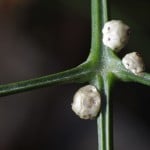 hard to notice at first and often grow into quite a colony before being detected. At only 3mm in length on average, scale insects have a brown shell that offers them protection against things like pesticides. Scale insects derive life from sucking the juices from your plant, as a colony grows they will start to cause obvious damage to your plant. You can kill them by using a cotton swab or Q-tip soaked with alcohol. (More information on Scale insects)
hard to notice at first and often grow into quite a colony before being detected. At only 3mm in length on average, scale insects have a brown shell that offers them protection against things like pesticides. Scale insects derive life from sucking the juices from your plant, as a colony grows they will start to cause obvious damage to your plant. You can kill them by using a cotton swab or Q-tip soaked with alcohol. (More information on Scale insects)
6. Thrips
These small, dark bugs are hard to see, plus they have wings and so when 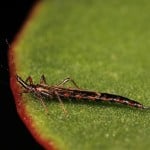 you spray the plant, you may notice they take off for flight and move to an adjacent plant. For this reason, a plant infested with thrips should be isolated. Thrips burrow into the leaves suck up the plant juices and leave behind noticeable scarring in the leaves. (Learn more about Thrips here)
you spray the plant, you may notice they take off for flight and move to an adjacent plant. For this reason, a plant infested with thrips should be isolated. Thrips burrow into the leaves suck up the plant juices and leave behind noticeable scarring in the leaves. (Learn more about Thrips here)
Preventing Bugs From Infesting Your Plants
Sometimes, no matter how hard you try a bug will find its way into your plant and create an entire colony. But for the most part, with careful watch and precautious plant care you can help keep the bugs from populating your greenery.
Ways to help keep bugs from infesting your plants include:
- Keep new plants isolated for at least one month before exposing the other plants to a possible bug. Check your isolated plant frequently for any signs of distress or infestation.
- Thoroughly clean the planter whenever repotting a plant
- Always keep your planters clear of old, dead leaves and foliage
- Use sterile potting soil. If you use garden soil for your planters you can encounter a world of issues, only partially related to bugs.
- Give your plants a good cleaning here and there using a soft cloth and lukewarm, non-toxic soap.
- Inspect plants regularly; a magnifying glass can be helpful to identify the start of mites, or other bugs, before they balloon out of control.
Should You Use Pesticides And Insecticidal Soaps On Your Plants?
Some pesticides might advertise for use on plants, but many are too strong and high in toxicity, causing damage to a plant faster than a bug colony. Also, most pesticides are not for use on indoor plants and require a well-ventilated area. Pesticides come with side effects to the environment, as well as your health. If at all possible, it’s best to find alternative, more natural solutions to getting rid of pests on your plants. If you must use a pesticide, you should always read the directions carefully and only use as directed.
Insecticidal soap is made of a potassium fatty acid that works against 40-50% of infestations related to soft-bodied bugs. Larger bugs or bugs with hard shells are much more difficult to get rid of using an insecticidal soap. Although more gentle than some pesticides, insecticides are still toxic and can cause irritation to human skin, as well as damage to your plants. Try spot treating first to make sure there are no negative implications to your plant before applying any substance over the entire surface (Read Here).
